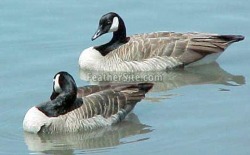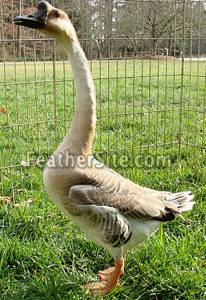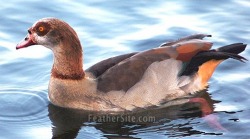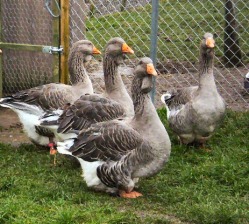T.C. Hatchery
Canadian Geese
~Current Amount: None
Chinese Geese
~Current amount: 1 brown cockeral
Addressing aggressive ganders The problem with some hand raised geese is they become too imprinted to their "human flock". When imprinted to humans, the human is viewed as the parent for the first 2-3 months; for which then the young geese see their human caregivers as flock members. By 5 months old, both goose and gander are at full height. At this point; young ganders view other geese or you, their human, either as a potential mate or a rival. Prior to this, just at 3 months old, ganders begin to try their dominance on each other and you, by gestures with head down, bill pointed up, or wings spread out.
Should you find that you are subject to such gestures, it is best to counter these threats as soon as they start. Step toward the bird; if he doesn't back off, grab a wing with a loose grip; as he tries to flee, release him. Repeat this as needed, he will try you several times until he gets the message. Be consistent.
Naturally to us this aggression is intimidating, and we pull or back away from those first nips. Doing that only secures the young gander's confidence in his new found dominance.
If you become the new owner of grown geese raised elsewhere; you may find a tyrant in the flock. Aggressive ganders have a guarded personal space they require, wether for themselves, or with a mate and/or brood. You will be punished if you ignore this space. This space can vary from just a few feet, to yards. If he demands a large distance, it may be necessary to relocate him, as it can grow to be intolerable to have him around; especially if there are small children.
It may not be too late to show this gander who is boss. When he advances toward you, be brave, (he can't kill you). Allow him to come at you, then grab him and pin him down. He'll flap, holler, and try to bite, but keep him down until he rests; then let him go. This may need to be repeated a few times before the behavior improves.
Wether your gander later becomes reformed or just a lawn ornament, either way, be sure that he is not harassed with chasing or teasing as this is a recipe for a nasty gander.And while we're on the subject of recipe, I vote a rogue gander is a roast gander.
Should you find that you are subject to such gestures, it is best to counter these threats as soon as they start. Step toward the bird; if he doesn't back off, grab a wing with a loose grip; as he tries to flee, release him. Repeat this as needed, he will try you several times until he gets the message. Be consistent.
Naturally to us this aggression is intimidating, and we pull or back away from those first nips. Doing that only secures the young gander's confidence in his new found dominance.
If you become the new owner of grown geese raised elsewhere; you may find a tyrant in the flock. Aggressive ganders have a guarded personal space they require, wether for themselves, or with a mate and/or brood. You will be punished if you ignore this space. This space can vary from just a few feet, to yards. If he demands a large distance, it may be necessary to relocate him, as it can grow to be intolerable to have him around; especially if there are small children.
It may not be too late to show this gander who is boss. When he advances toward you, be brave, (he can't kill you). Allow him to come at you, then grab him and pin him down. He'll flap, holler, and try to bite, but keep him down until he rests; then let him go. This may need to be repeated a few times before the behavior improves.
Wether your gander later becomes reformed or just a lawn ornament, either way, be sure that he is not harassed with chasing or teasing as this is a recipe for a nasty gander.And while we're on the subject of recipe, I vote a rogue gander is a roast gander.
Egyptian Geese
~Current amount: None
These geese are native to Africa, south of the Sahara, and throughout the Nile Valley. Both sexes look alike; the females are slightly smaller, but not enough for readily identifying their sex. Sexing is done easily by ear, however: only the ganders hiss, while the females make a loud cackling call. Although they swim well, Egyptian geese spend most of their time on land.
Although easy to maintain in captivity they are usually quite quarrelsome and a mated pair will often drive off all other waterfowl and break every egg they find that is not theirs. Therefore, they should not be kept in a mixed group of fowl unless in a very large enclosure.
Although easy to maintain in captivity they are usually quite quarrelsome and a mated pair will often drive off all other waterfowl and break every egg they find that is not theirs. Therefore, they should not be kept in a mixed group of fowl unless in a very large enclosure.




